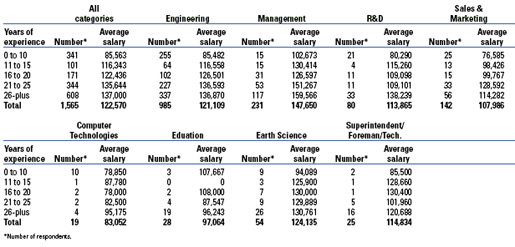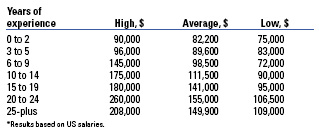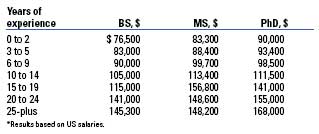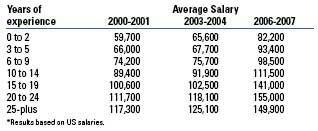INDUSTRY RECRUITMENT & RETENTION
Salaries take a pronounced jump higher
Results of the SPE and AAPG salary surveys show significant increases.
Ira Kempf, BP Exploration & Production, Inc., Houston
To no one's surprise, salaries for engineers and geoscientists continued their dizzying climb to new heights over the last year, according to the most recent data from SPE and AAPG. Both associations reported a remarkably consistent, overall salary increase figure of 9%. Their respective findings are summarized below.
SPE. In 2006, The Gallup Organization collected confidential worldwide salary information on behalf of SPE. Gallup contacted members in 51 countries. The summarized results include responses from 1,565 members in the US and 1,186 members from other countries. For the purposes of this summary, respondents who were semi-retired, retired or unemployed were excluded. As in the previous study, individuals reporting annual salaries of less than $24,000 or more than $250,000 were also excluded. All salary and income figures were reported in US dollars.
Worldwide, respondents reported an average income of $116,834. Respondents also said that they earned an additional $56,975 in bonuses, housing and retirement funds, and 33% have a car or car allowance. Members' incomes increased 9% over the last year. Worldwide, US respondents and members from the North Sea region reported the highest average incomes, $122,570 and $116,092, respectively. South Americans/Caribbean reported the lowest average incomes ($89,575), as was true in 2004. African respondents reported the highest average additional income of $136,830 (including bonuses, housing and pension plans). Respondents from the North Sea and South Central and Eastern Europe were, by far, the most likely to have pursued education beyond a bachelors degree, 69% and 68% respectively. Of the different regions examined, Canadian respondents were the least likely to have additional education (30%). Members from the Middle East, and South Central and Eastern Europe, were the most likely to have a car or car allowance, but fewer in Canada and the US had a car or car allowance.
In the US (see SPE table), respondents were asked in both 2002 and 2004 to specify their annual base salary. Compared to 2004, the average annual, US figure rose from $109,014 to $122,570, for a 12% increase. Members were also asked to estimate the percent by which their base salary increased in the last year. The self-reported average increase (9%) among US members was lower than the estimate (11%), based on reported salaries. This difference may be due to overstatement of salary figures, underestimates of increases, the compounding of increases over the last two years, or other factors. The average US respondent was 45 years old, with 17.5 years of industry experience. Over one-third have completed education beyond their bachelors degree. The average member salary was based on 1,565 responses. About one in four (24%) had a car or car allowance. Virtually all of those working in the US are citizens (89%). US citizens earned 16% more than those who are not citizens. Five job description categories (Engineering, Management, Research and Development, Earth Science and Sales) had large enough sample sizes to examine trends according to years of experience.
AAPG. Salaries for petroleum geologists took another jump in 2006-2007, with a weighted average increase of 9.1%, overall, in pay, according to the new, annual AAPG Salary Survey. Conducted annually since 1981 by Mike Ayling of MLA Resources in Tulsa, Okla., the survey showed the 15-19-year experience category charting the largest increase, with an 18% raise in salaries.
| SPE Dec. 2006 salary survey: US results, salary by job description and experience |
 |
|
| AAPG 2006-2007 geological salary survey* |
 |
|
| AAPG survey: Average salary by degree* |
 |
|
| AAPG salary survey: Historical averages* |
 |
|
Entry-level geologists had a 9.5% increase, with the 3-5 year category geologists' pay rising 13%. The 20-24-year and 25-year-plus experience categories also recorded double-digit increases, with 10.3% and 10.5% hikes, respectively. The 10-14-year experience category charted a loss of 2.5% in recorded salaries, but Ayling noted that this group's anomaly was due to a lack of adequate data points, as has been true for this group always, as it matriculates through the career cycle. It is this same age category that recorded little entry-level hiring during a downturn in the industry in the early-to-mid 1990s.
Ayling found that 2006 �showed fits and starts in hiring activity, somewhat driven by the rapid build and then decline in oil prices, which, in some cases, led to caution on the part of employers.� Comparatively, the 2005-2006 salary survey showed an overall 16% salary increase.
AAPG's survey is based on employed, salaried geoscientists and salaries, alone. It does not include bonuses, employee benefits, autos or other perquisites. It does not include anyone whose compensation is from consulting fees, retainers or overrides. The survey is also based on US salaries. The measurement for international salaries for explorationists is virtually on a country-by-country, case-by-case basis, said Ayling, who sees a �changing of the guard� occurring.
�The geoscientists that were the youngsters in the mid 1970s growth spurt are now reaching retirement (not early retirement) age,� he said. �I was chatting with one recently, and he tells me that at 64, he's ready to do something else. He is fortunate to have made a good deal over the years, and can now take the time to pursue other interests. �This does not bode well for our industry.�
Meanwhile, Ayling said that many geologists in the 20-year category have benefited from the lack of experienced geoscientists. �Individuals with whom I spoke two years ago have seen their salaries jump from the mid-$120's to over $165,000, for staff level positions. At some point, however, merely paying higher dollars isn't going to attract talent in sufficient numbers.� Thus, he noted, job satisfaction becomes a priority for an already-employed explorationist.
While the 2006 numbers again came in strong, Ayling said that he is �concerned about what 2007 has to offer. �There are rumors of layoffs to be associated with several large industry mergers,� he said. �On the other hand, with a rig count that has doubled since 2003 and grown by close to 20% over the past year, activity has continued to stay strong.� The apparent contradiction of layoffs in the face of increased activity is created by mergers and acquisitions, and rumors of such that also cloud the hiring climate in the minds of some senior managers. 
|






